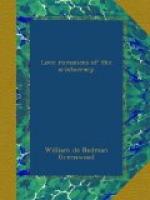Thus perished, little past the prime of life, a man who more than any other of his day drained the cup of pride and pleasure, to find its dregs exceeding bitter to the taste.
CHAPTER XXII
TWO IRISH BEAUTIES
In the winter of 1745 the city of Dublin was thrown into a state of high excitement by the appearance of a couple of girls from the wilds of Connaught, whose almost unearthly beauty won the instant homage of every man, from His Excellency the Earl of Harrington, then Lord Lieutenant, to the sourest jarvey who cracked a whip in her streets. To quote the pardonably extravagant language of a chronicler of the time,
“They swam into the social firmament of the Irish capital like twin planets of dazzling splendour, eclipsing all other constellations, as if the pall of night had been drawn over them.”
They had grown to girlhood, so the story ran from mouth to mouth, in a ruinous thatched house, in the shadow of Castle Coote, in County Roscommon, and were the daughters of John Gunning, a roystering, happy-go-lucky, dram-drinking squireen, whose most serious occupation in life was keeping the brokers’ men on the right side of his door. And at the time this story opens they were living in a cottage, rented for a modest eight pounds a year, on the outskirts of Dublin, with their mother, who was a daughter of Lord Mayo.
To say that all Dublin was at the feet of the Gunning sisters, at the first sight of their lovely faces and dainty figures, is an unadorned statement of fact. The young “bloods” of the capital were their slaves to a man, ready to spill the last drop of blood for them; and every gallant of the Viceregal Court drank toasts to their beauty, and vied with his rivals to win a smile or a word from them. Peg Woffington, it is said, threw up her arms in wonder at the sight of them, and, as she hugged each in turn, declared that she “had never seen anything half so sweet”; and Tom Sheridan went down on his knees in involuntary homage to the majesty of their beauty.
It was Tom Sheridan who placed his stage wardrobe at their disposal when they were invited to the great Viceregal ball in honour of King George’s birthday; and, attired as Lady Macbeth and Juliet respectively, they danced the stately minuet and rollicking country dances with such grace and abandon that lords and ladies stopped in their dances, and mounted on chairs and tables to feast their eyes on so rare and ravishing a sight.
“With Betty as with Maria,” says Mr Frankfort Moore, “the art of the dance had become part of her nature. Her languorous eyes were in sympathy with the voluptuous movements of her feet and lithe body, and the curves made by her arms formed an invisible chain that held everyone entranced. The caresses of her fingers, the coyness of her curtsies, the allurements of her movements—all the graces and charms inwoven that make up the




